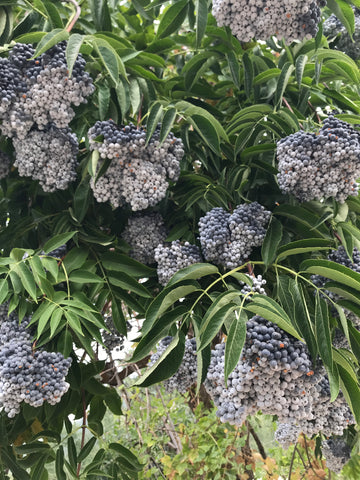A particularly challenging plant to grow from seed, we’re working on developing and documenting the best practices for West Coast native elderberry propagation. Typically, favored cultivars of elderberry are propagated via cuttings. This is a reliable method to generate genetically identical plants, however we are looking to promote genetic diversity and grow far more plants at once. We’d like to equip everyone with the tools to do the same. Come take the journey with us.
Collecting wild berries
The first step collecting wild elderberries is finding and correctly identifying the plants. There are a few native species to California, but we are going to focus on the blue elderberry, Sambucus caerulea which can be found all the way up the West Coast of the US. Blue elderberry likes drier, sunny, open forested areas, but can also be found stabilizing soil along riverbanks. At forests edge, in full sun, with full access to water, the plants can get massive.

They have large opposite compound leaves with 5 to 9 broadly lance-shaped, smooth, toothed leaflets.

In California, they flower in early summer. When flowering, they have large pillows of creamy white flowers with a lovely anise-like scent.

As the berries ripen, they go from green, to dark blue, and finally get a powdery light blue bloom that indicates peak ripeness.

When you find a ripe cluster from a plant you’ve properly identified, clip at its base.

And place your clusters into a sealed bag, for refrigeration, or to be processed immediately.

Processing the berries
Once you’ve gotten back it’s time to process the berries! Using a food mill, separate the berry flesh from the seeds.

Then, using a fine mesh strainer, separate the seeds from the juice and rinse them.

Add seeds to moist vermiculite. The moisture level of vermiculite should be similar to a sponge that has been rung out completely, wet but not dripping.
Leave the seeds and their new moist media in a room temp/warm location, out of direct sunlight.
What next?
For our guide on direct sowing, seed treatments and stratification methods - look out for our next article!

